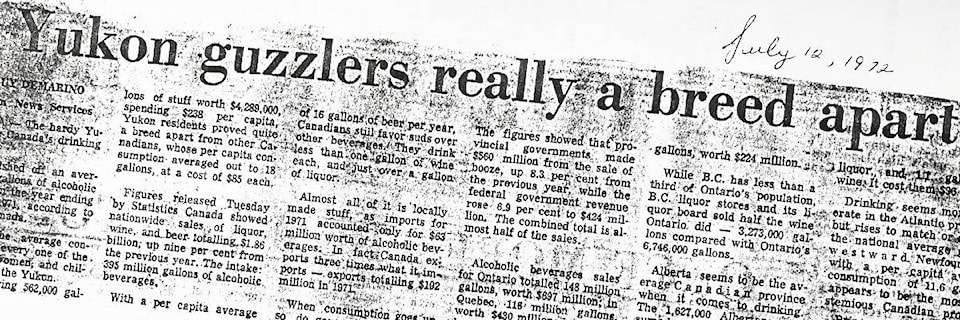In the midst of the Yukon’s health emergency declaration, Canadian research studies on substance use are recommending stricter limits for alcohol.
Researchers from the Canadian Centre on Substance Use and Addiction (CCSA) called for reductions to the safe drinking guidelines and for mandatory warning labels to expose the link between drinking alcohol and cancer Aug. 29.
The new CCSA guidelines are one of several attempts to connect consumers with the reality of alcohol as a major carcinogen, alongside tobacco and asbestos.
The new reduced guidelines call for zero to two drinks per week to be safe. This is a substantial reduction from 10 drinks per week for women and 15 for men. For Yukoners, who are statistically understood to drink substantially more than that, the guideline calls for an even more dramatic reduction.
In a 2015 Yukon health status report by Dr. Brendan Hanley, former chief medical officer, the average Yukoner was found to consume 3.8 drinks per drinking occasion. The top percentage of drinkers were found to consume 10.4 drinks per occasion.
His report also says that Yukoners suffer more harms — cancers, violence, accidents, incarcerations, homicides, suicides, aggression, family troubles and other injuries than other Canadians.
The Yukon has a culture of drinking, he said.
“So alcohol gets forgotten, because we’re all kind of used to alcohol, and alcohol is very normalized. Yeah, but it’s still killing us in various ways,” Hanley said.
In 2017, the Yukon government backed out of an experimental program to place warning labels on liquor bottles just one month in, given threats of litigation from liquor producers. A CCSA report from 2019 says the Yukon’s reluctance sparked international media coverage.
Hanley’s 2015 report is the last comprehensive report on health related to substance use in the territory. Southern Canadians are surveyed every two years as part of the Canadian Alcohol and Drug standardized survey, but it excludes the three northern territories. Only in 1990 and 2005 was this survey administered in the Yukon.
Yukon sales data per person over 15 years of age has long exceeded the Canadian average. The most recent data from Statistics Canada for 2020/2021 indicates that alcohol consumption in Yukon increased, even without any tourists.
“Finally, we have the proof,” said Dr. Brendan Hanley, former chief medical officer of health and Yukon’s MP, half joking about the decades-long political rational of using tourists to brush off Yukon’s high consumption rates, as he talked with the News Aug. 23.
One way statisticians track liquor consumption is to track per capita sales by volume of pure alcohol annually.
Canada’s measure is 8.3 litres; Yukon’s is 13.3. All jurisdictions saw a slight increase during the pandemic, with British Columbia and Alberta increasing to 9 litres. Yukon still tops the international measure.
“If you are number one, you are number one,” Dr. Tim Niami, director at UVic’s Canadian institute for substance use research (CISUR), told the News Aug. 29.
He said the per capita consumption is a good, methodically stable measure, and it correlates with everything else.
“We pretty much know it would be mathematically impossible not to have a high per capita consumption level reflecting a high heavy drinking rate.”
Hanley says the Yukon’s data set is on shaky ground. He can’t tell how tobacco use is trending, has no sense of prescription drug use in the territory and believes the opioid problem has come on top of the alcohol situation.
“I would be surprised if things have changed much in terms of alcohol consumption since 2015,” he said.
Hanley believes we need to take a 20-year window on the problem. He said his hopes were raised with the new Yukon Liquor Act. His team developed recommendations to insert a greater public health perspective into the regulations on areas such as pricing, hours of off-sales, labelling and other policy initiatives.
The Yukon’s new act was passed in 2019, but has yet to be proclaimed, pending new regulations. Spokesperson Amelie Quirke-Tomlins from the Yukon Liquor Corporation wrote in an email, “the regulations will be completed as soon as practicable.”
Niami, who recently came to CCSA from Boston University, views the problem through years of rigorous studies.
“I am a researcher, and basically youth alcohol consumption pretty much follows that of adults,” he said. “So, if you actually want to address youth drinking, you have to address adult drinking first.”
He thinks that programs to reduce youth drinking are wasted without attention to the drinking of the adults around them.
“This is a complete fantasy world that we can just have some educational program for youth. And meanwhile, all the adults are drinking a ton. And then we’re going to pretend that that’s really addressing youth drinking. Because it won’t.”
It is expected that the new guidelines on consumption won’t be official in Canada until November following a period of public consultation.
Contact Lawrie Crawford at lawrie.crawford@yukon-news.com
